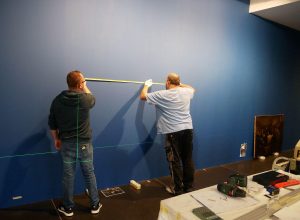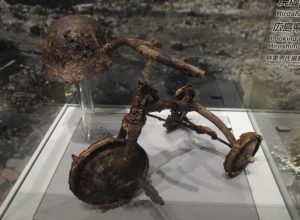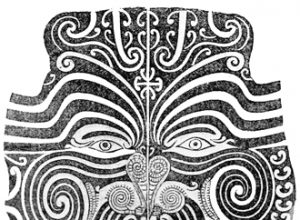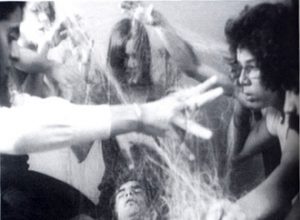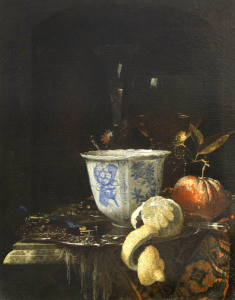
Museums are not self-evident entities. David Guillet, who has experience thereof, reflects on the status of things—drawings, for example—whose complexity, materiality, and multiple qualities, as well as their diversity of significations, he wishes to grasp.
He isolates problems without concealing the limits encountered by visitors when offered only a linear path through a museum’s collections. While there is no path to salvation either along the syntagmatic axis or along the thematic axis, he does offer solutions that favor the unfolding of perception. Returning to philosophy (particularly that of Edmund Husserl and that of Walter Benjamin), he highlights the innovative character of certain museum exhibitions.
Laurence Bertrand Dorléac
Things in the Museum:Historical Objects, Memorial Objects, Constructed Objects
David Guillet
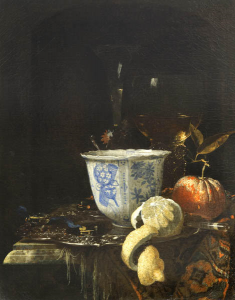
Willem Kalf, (Rotterdam 1619 – 1693 Amsterdam) Still life with a Chinese porcelain bowl. Canvas, 52.5 x 41.8 cm; signed ; inv. 388. © Fondation Custodia, Collection Frits Lugt, Paris. DR.
Drawings
Beginning our reflections with the graphic arts and, more specifically, with the art of drawing shall prove to be particularly instructive. Drawing, as one knows, is the most convenient way, with a still unfinished work in mind, to jot down on paper a project and even just an intention, a first thought. The apparent homonymy, in French, between dessin (drawing) and dessein (design), which in fact designate one and the same thing, sums this up quite well. In Florentine theories of art, notably Giorgio Vasari’s, drawing is the expression of the idea, the proof that the artist is first and foremost an inventor, and not an artisan, and that his activity pertains to the liberal arts and not to the mechanical arts. Moreover, the first modern arts academy was the Academia delle arti del disegno, which was created in 1563 by Cosimo I de’ Medici.
And yet, a drawing is a thing endowed first and foremost with material characteristics, and its materiality sometimes looms as more important than the pure intention animating the artist, however little one makes an effort to look at it with an unbiased eye. Thus, it owes much to the more or less fortuitous circumstances of its execution: done on a sheet liable to be reused, sometimes it is placed alongside another rough sketch [croquis] not directly related to it done on the same side or on the other side of the sheet, under different circumstances, and sometimes even by someone else’s hand. Moreover, the distinction between front and back is constructed a posteriori, as that pertains to the work’s reception and to an interpretation that is subject to changes of opinion! These are so many reasons why some drawings resist being grasped immediately, appear as enigmas, and do not readily lend themselves to exhibition—like ones inopportunely executed on both sides of the same sheet, only one side of which one must reconcile oneself to presenting, unless one wants to force the visitor to crane his neck in order to contemplate the other one, drawn “upside down,” which defies the laws of gravity. The museographer finds it hard going just to get anything out of them at all.
Especially when a drawing is a preparatory study for a finished work, it constitutes, at the moment of its execution, a stage, a means, a tool in a material process for the elaboration and dissemination of a work. The best sign of this is that the artist who executes it or his studio collaborators, the person who commissions it, the seller, and then the collector do not hesitate to mark it up to indicate its intended usage, whether those for whom such alterations will have disrupted the study or enjoyment thereof like it or not. Going well beyond the idea one might have of the work, these are so many significant material characteristics that yield as many meanings, so that one really wants to look at it a number of times. One can mention:
■ Grid patterns—on what is called graph paper—meant to facilitate the drawing’s transfer, including by a third person, onto a sheet of greater dimensions or onto a canvas;
■ Still more intrusive: pinholes or notches, which mark out the drawing’s contours and allow its transfer but hinder the reading of the original and, still more, of a drawing that may have been executed on the rear side;
■ Piercing, which allows one to fasten the drawing comfortably at eye level on scaffolding near the fresco on which the transposition takes place;
■ Handwritten notes by the artist, allowing him to keep in mind some detail for the execution of the definitive work—such as a color—that has been agreed upon with the person who commissioned the work and/or is intended for collaborators;
■ Handwritten notes, done by a collaborator who is responsible for transposing the master’s work and is concerned with identifying its motif or its purpose;
■ Annotations relating to something everyday or to a payment made in the studio, inscribed on the back of the sheet or even on the front;
■ Notes, signatures, or monograms of the artist himself and/or of the person who commissioned the work, which make some drawings the material medium for the contract between the parties, that is to say, a stage in the process of the production of the work;
■ Insertion of the work in a greater whole not intended by the artist, though desired by the collector in order to show it to advantage, in accordance with the idea he has of it, in the place he assigns to it in his collection. This is the case with the frames made by Vasari for the drawings in his collection;
■ Finally, the “reworking” of the drawing by one of the work’s owners, well after its execution. Peter Paul Rubens was known to have retouched some of the works in his collection that are attributable to other draftsmen.
These examples testify to the fact that a drawing is much more than the work with which it is first identified. Added thereto are other, equally material considerations relating to the fragility of the medium and the delicateness of the drawing—which is its very own special way of being a museum object, as opposed to a marble or a monumental bronze, a tapestry or a historical painting. In a museum, nothing is so easily lost as a drawing that has accidentally slipped into a box other than its own; nothing can more quickly undergo deterioration through some blunder, as the custom of graphic arts departments’ prohibition of the usage of pens reminds us. The material character of a thing is expressed, too, by its perishableness: in this regard, one is not far removed from the notion of a vanity.
Polysemy and Linearity
More broadly speaking, a drawing, like any other museum object, offers a rich variety of gazes that may be cast upon it, depending on the person who does the gazing, the point of view s/he adopts, the nature of the interest s/he takes in it, and what s/he discovers therein. The question is then raised, within the museum world, of how to do justice to such diversity, to this polysemy of the object, and of how to account for the multiple significations it can take on, depending upon the way in which it is presented, the environment that is created to that end, and the other objects—or works—among which one chooses to place it, knowing that it can, as a matter of fact, occupy only a single place at a time. Above all, how is one to think this question in order to master all the issues at stake and to avoid giving thereto answers of a merely technical nature?
To a great extent, the difficulty lies in the linearity of the path—which is a spatial transposition of the discourse—a museum, in essence, proposes. Such linearity is inevitable, since the visitor’s stroll through the museum has a beginning and an end that are more or less explicitly imposed upon him/her. It is in between this beginning and this end that exhibited objects take the places assigned to them, like the words of a sentence which a syntax connects together in order to structure the statement and yield an overall meaning, and in the face of which all the particular meanings each of its words could otherwise take on fade away.
Roman Jakobson’s Fundamentals of Language defines in this way the syntagmatic axis along which the sentence’s words—syntagms—are deposited, and the sentence is what confers upon each of them the meaning that is attributed to it for the occasion, to the exclusion of every other meaning, or nearly so. And yet, there exists a paradigmatic axis—which could be described as virtual—that associates with each word a synonym or, more significantly, another word that is tied to it by some kind of semantic, sonorous, or etymological similarity or affinity, as an echo, redundancy, or variant, even a variation.
Quite obviously, in a chronological type of presentation the syntagmatic axis is essentially preponderant, even exclusive. Nonetheless, thematic types of presentation can prove to be just as impoverishing for the work or the object whose context, created or recreated for the needs of the cause, mobilize and highlight, quite often, only one aspect expressly chosen for this end.
To escape therefrom, there are at least two solutions:
■ The first is to isolate the work in order to lend it some life and allow it to express itself; in order—especially—to allow those who contemplate it to find therein, in a completely unbiased way, what they are seeking or, conversely, what they do not expect to find therein and what it will reveal to them. That is what is at stake in a passage from Marcel Proust’s Within a Budding Grove, which evokes this approach in terms characteristic both of a historical era and of a particular social milieu. In a funny way, the early twentieth-century private mansion, as placed in the hands of the hostess who prefigures the interior decorator, reminds one of certain highly present, indeed historicizing, museographies—whereas museums were looked upon at that time as ideal places where art works would be free of any discourse, any teleology.
But in this respect as in every other, our age is infected with a mania for shewing things only in the environment that properly belongs to them, thereby suppressing the essential thing, the act of the mind which isolated them from that environment. A picture is nowadays “presented” in the midst of furniture, ornaments, hangings of the same period, a secondhand scheme of decoration in the composition of which in the houses of to-day excels that same hostess who but yesterday was so crassly ignorant, but now spends her time poring over records and in libraries; and among these the masterpiece at which we glance up from the table while we dine does not give us that exhilarating delight which we can expect from it only in a public gallery, which symbolises far better by its bareness, by the absence of all irritating detail, those innermost spaces into which the artist withdrew to create it.[ref]Marcel Proust, Within A Budding Grove, trans. C. K. Scott Moncrieff http://www.planetebook.com/ebooks/Within-a-Budding-Grove.pdf, p. 328[/ref]
■ The second, less radical and more didactic, solution consists in placing a work or a museum object at the very center of a circular and nonlinear arrangement that radiates outward or is organized concentrically, similar to a diagram that better renders the multiplicity of issues at stake as well as the connections each of them may have with the others. In fact, such an arrangement is, at least as much as—if not very much more than—the linearity of a chronology, a construction performed by the museum, by the curator, or by the person who commissioned the work. At least an arrangement like that leaves it up to its audience to make an apparent choice between the various options being presented: the choice to retain only one of them, the choice of the order in which they might be explored. There is, therefore, a choice among several possibilities—which are limited in number, of course, yet it nonetheless is indeed a choice, the choice to try out some options in succession and to link together several of them.
Perception and Construction of Things—Edmund Husserl
When responses given by the museum institution to the challenges of presenting objects in its collection all bear on their contextualization, on the aesthetic or, more simply, geometric form of their environment, it is clear that the issue at hand touches on how these objects are perceived.
Without having any direct application to our argument here, Edmund Husserl’s theses on the perception of things furnish, at least, a stimulating model that is liable to shed some light on these issues and to inspire some solutions. In his Ideas: General Introduction to Pure Phenomenology, Husserl distinguishes the lived experience that is given immediately and as such in immanent perception from the thing, which, for its part, manifests itself in transcendent perception as a unity within a manifold in an ever changing, never definitive fashion, no point of view on it being capable of claiming to give it once and for all and absolutely. In other terms, it is consciousness that gives its meaning to things, that constitutes them, properly speaking, and it is this notion of a constitution of things that lies at the heart of his thought.
This process of constitution of things results, Husserl tells us, from a succession of iterations, things giving themselves out through stages he designates as Abschattungen, a term Paul Ricœur translates into French as esquisses (sketches). More explicitly, it is the succession of sketches perception generates that ends up constituting things as such. The unity of a thing results from the infinity of successive sketches consciousness produces, juxtaposes, or superimposes. Intuition and intelligence allow one to apprehend “regulated series of appearances that necessarily hold together within the unity of a single appearing object”;[ref]Edmund Husserl, Ideas: General Introduction to Pure Phenomenology, trans. W. R. Boyce Gibson (London: Collier-Macmillan, 1962), §150, p. 386.[/ref] in other words, to constitute a thing on the basis of sensory data is to reconstitute the experience of this thing in its diversity.
Without reducing or instrumentalizing this thought, it seems appropriate to take some inspiration therefrom in order to approach the works and objects museums exhibit and perhaps, too, in order to present them and render them comprehensible in their complexity—which necessitates that one return to them several times, refresh one’s points of view, and take one’s time, thereby multiplying the number of experiences one has of them. Several recent initiatives proceed along such paths while proposing some audacious and fresh approaches. That is the case with the temporary exhibition Carambolages conceived by Jean-Hubert Martin, which was presented at the Grand Palais in Paris, but also with the new presentation of the permanent collections at the Museum Angewandte Kunst of Frankfurt, inaugurated in 2014. Under the title Elementarteile: Aus den Sammlungen, that new presentation exhibited, without employing any teaching tools, some pieces from quite a variety of eras and geographical areas, with them grouped as elementary particles, detached from their original context, whose associations the visitor is left to decrypt or, rather, to construct as s/he pleases while drawing inspiration from Friedrich Nietzsche’s The Gay Science.
Things in History: Walter Benjamin
Two texts written by Walter Benjamin in the last years of his life open up other stimulating prospects. They are: On the Concept of History, which dates from 1940 and appeared after the author’s death in an undoubtedly nondefinitive form, and Eduard Fuchs: Collector and Historian, a commissioned work published in 1937. In a both paradoxical and significant fashion, the earlier text, though a completed, published, and more lengthy work, appears a posteriori as a first way of thinking the second, brief, fragmentary work, which remained unpublished until 1942. It is therefore in starting from some reflections about the figure of a collector and his relationship with things that Benjamin composed a more ambitious text on history. One will not be surprised that dialectical materialism constitutes the backbone for both these texts.
Eduard Fuchs was a compulsive collector, closer to Balzacian figures than to his contemporaries, the Goncourt brothers. What interested him were the Honoré Daumier prints he bought in Paris, revolutionary-era engravings, erotic and indeed pornographic prints, and sculptures from the Tang period. He explored “marginal areas . . . which sooner or later meant the ruin of a whole series of cliches in traditional art history.”[ref]Walter Benjamin, “Eduard Fuchs, Collector and Historian,” in The Work of Art in the Age of its Technological Reproducibility, and Other Writings on Media, ed. Michael W. Jennings, Brigid Doherty, and Thomas Y. Levin, trans. Edmund Jephcott, Rodney Livingstone, Howard Eiland, and others (Cambridge, MA: The Belknap Press of Harvard University Press, 2008), p. 125.[/ref]
In Fuchs, the collector is French, the historian German, we are told by Benjamin, who does not miss an opportunity to present him as a “pioneer of a materialist consideration of art”[ref]Ibid., p. 117.[/ref] and to emphasize his—direct or indirect, real or virtual—exchanges with Friedrich Engels. His premise is to admit without reservation that only in isolated instances has it been possible to grasp the historical content of a work of art in such a way that it becomes more transparent to us as a work of art. All more intimate engagement with a work of art must remain a vain endeavor, so long as the work’s sober historical content is untouched by dialectical knowledge.[ref]Ibid., p. 119.[/ref]
In doing so, he settles his scores with Idealism, which is embodied by two syndromes:
■ That of “once upon a time” and of “the eternal image of the past,” which he contrasts with “a given experience with the past—an experience that is unique,” the condition for which is “the replacement of the epic element by the constructive element,” in order to speak to “a consciousness of the present which explodes the continuum of history.”[ref]Ibid., pp. 118-19.[/ref]
■ That of the linear view of history, which he invites one to consider as “the object of a construct whose locus is not empty time but rather the specific epoch, the specific life, the specific work,” and to blast “the epoch out of its reified ‘historical continuity,’ and thereby the life out of the epoch, and the work out of the lifework,” while endeavoring to achieve the “preservation and sublation [Aufhebung] of the lifework in the work, of the epoch in the lifework, and of the course of history in the epoch.”[ref]Ibid., p. 118.[/ref] What we find developed again here are the images of the forms that serve as alternatives to the linearity of a museum’s chronological itinerary: the blasting apart of the thing and its recontextualization via concentric circles connected together by a dialectical relationship.
Passing from things to history, Benjamin calls for a “historical science which fashions its object not out of a tangle of mere facticities but out of the numbered group of threads representing the woof of a past fed into the warp of the present,” adding that it “would be a mistake to equate this woof with mere causal connection. Rather, it is thoroughly dialectical. For centuries, threads can become lost, only to be picked up again by the present course of history.” The metaphor of a tangle, of threads and fabric, opens up prospects regarding networks of meaning that connect objects together, connect objects and their context, connect the past and the present, and connect together different eras of what by convenience is called the past.
In conclusion, let us take a concrete example offered by Benjamin:
History is the object of a construction whose place is formed not in homogenous and empty time, but in that which is fulfilled by the here-and-now [Jetztzeit]. For Robespierre, Roman antiquity was a past charged with the here-and-now, which he exploded out of the continuum of history. The French revolution thought of itself as a latter-day Rome. It cited ancient Rome exactly the way fashion cites a past costume. Fashion has an eye for what is up-to-date, wherever it moves in the jungle [Dickicht: maze, thicket] of what was. It is the tiger’s leap into that which has gone before.[ref]Walter Benjamin, “On the Concept of History” (1940), trans. Dennis Redmond; http://www.marxists.org/reference/archive/benjamin/1940/history.htm §XIV.[/ref]
When the dialectic is embodied in the intuition and is expressed by such metaphors, there is nothing left to do but to bow down.
Bibliography
Benjamin, Walter. “Eduard Fuchs, Collector and Historian.” 1937. In The Work of Art in the Age of its Technological Reproducibility, and Other Writings on Media. Ed. Michael W. Jennings, Brigid Doherty, and Thomas Y. Levin. Trans. Edmund Jephcott, Rodney Livingstone, Howard Eiland, and others. Cambridge, MA: The Belknap Press of Harvard University Press, 2008.
_____. “On the Concept of History” 1940. Trans. Dennis Redmond. http://www.marxists.org/reference/archive/benjamin/1940/history.htm
Husserl, Edmund. Ideas: General Introduction to Pure Phenomenology. Trans. W. R. Boyce Gibson. London: Collier-Macmillan, 1962.
Jakobson, Roman, and Morris Halle. Fundamentals of Language. The Hague: Mouton, 1956.
Martin, Jean-Hubert. Carambolages. Grand Palais Exhibition catalogue. Paris: Réunion des musées nationaux et du Grand Palais des Champs-Élysées, 2016.
Panofsky, Erwin. Idea: A Concept in Art Theory. New York: Harper & Row, 1968.
Proust, Marcel. Within A Budding Grove, trans. C. K. Scott Moncrieff. http://www.planetebook.com/ebooks/Within-a-Budding-Grove.pdf
After studies in Arts and in French and German Literature and several years of teaching, in particular at the Berlin’s Technische Universität, David Guillet has worked at several French national heritage institutions, including the Musée d’Orsay, the French National Galleries of the Grand Palais, the Réunion des Musées Nationaux, and then the French Army Museum, where he served as deputy director from 2009 to 2017. He is the author of numerous articles and exhibition catalogues that bear mainly on the history of drawing and prints from the fifteenth to the eighteenth centuries, in Germany, the Old Netherlands, and France.
